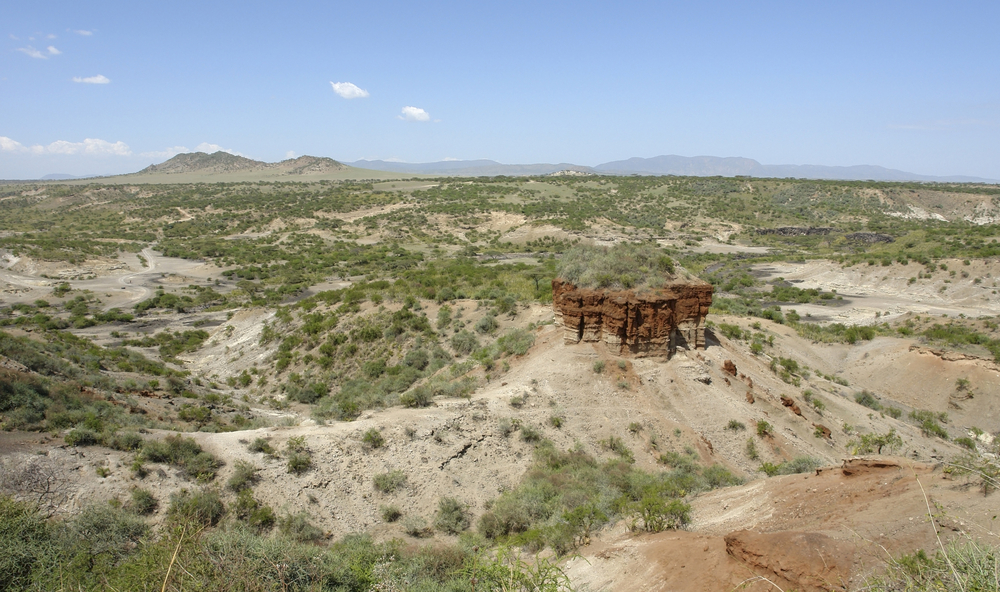Olduvai Gorge: Oldest Evidence of Mankind's Evolution

Olduvai Gorge is a site in Tanzania that holds the earliest evidence of the existence of human ancestors. Paleoanthropologists have found hundreds of fossilized bones and stone tools in the area dating back millions of years, leading them to conclude that humans evolved in Africa.
Olduvai is a misspelling of Oldupai, a Maasai word for a wild sisal plant that grows in the area. The gorge is located in the Great Rift Valley, between the Ngorongoro Crater and the Serengeti National Park. It is 30 miles from Laetoli, another fossil-rich area. Olduvai Gorge was formed about 30,000 years ago, the result of aggressive geological activity and streams.
The steep ravine is about 30 miles (48.2 km) long and 295 feet (89.9 meters) deep, not quite large enough to be classified as a canyon. A river cuts through several layers to form four individual beds, with the oldest estimated at about 2 million years old.
The first family of paleontology
Louis and Mary (Nicol) Leakey are often referred to as the first family of paleontology, as much of their lives, and later the lives of their children, revolved around Olduvai Gorge. The couple met on a dig in England, and both worked briefly at the Olduvai Gorge before being married in England in 1937.
Louis was born in 1903 in Kenya, where his English parents were missionaries. He would often uncover prehistoric stone tools while he was out bird watching. After graduating from University in England, he joined a fossil-finding expedition to what is now Tanzania, which sparked his interest in human origins.
In 1930s, the Leakeys found stone tools in Olduvai and elsewhere. Among their most notable finds were several extinct vertebrates, including the 25-million-year-old Pronconsul primate, one of the first and few fossil ape skulls discovered.
Political unrest in nearby Kenya forced them to put their work on hold, but they went back to Olduvai Gorge in the late 1950s. While they had focused on tools in their previous work at the gorge, they went back to look for further evidence of human life.
Get the world’s most fascinating discoveries delivered straight to your inbox.
One day in 1959, Mary went out to work as usual, leaving Louis behind with a headache. She discovered fossilized parts of a skull and upper teeth of a type of hominin that had not been previously identified.
Over the next several weeks, the Leakeys uncovered about 400 pieces of a nearly complete skull. There were similarities to other discoveries, including those in South Africa by Raymond Dart in 1924 and by Robert Broom in 1936. However, the Leakeys classified their find as new category of hominin, dubbing it Zinjanthropus boisei.
It was not the direct ancestor of humankind that the Leakeys had hoped for, but it brought the couple some notoriety and spurred public interest in the study of human origins.
They dated the discovery as having lived 1.75 million years ago. This made it the oldest hominin discovered to that point, although a lack of fossil-dating technology made it difficult to determine the age of Dart’s and Broom’s earlier finds. The combination of the works of the Leakeys, Dart and Broom made a convincing case that humans originally evolved in Africa.
By 1960, Louis Leakey had become ill and Mary took over most of the operation. There were a number of developments during this period. They uncovered a well-preserved fossil foot that had arches, giving credence to the theory that hominins walked upright.
During this time, Mary Leakey and son Jonathan found another, smaller form of hominin that they called Homo habilis, translated as "handy human," because it seemed he was able to use tools. This fossil was dated at about 2 million years old. This was confirmed when another son, Richard, discovered another Homo habilis in 1972.
This 1972 discovery also supported the elder Leakey's theory that there were several lines of hominins developing simultaneously and that the Homo genus did not evolve from Australopithecus. [Know Your Roots? Take Our Human Evolution Quiz]
Twiggy
In 1968, a 1.8-million-year-old skull discovered in 1968 by Peter Nzube, who was part of the Leakey team. Nicknamed Twiggy, after the slim British model, the skull was flattened and had to be reconstructed from hundreds of fragments. Since her third set of molars had erupted, Twiggy was believed to have been an adult at death. However, the molars did not show much wear, so it is likely she had much time to use them.
But the Leakeys were not responsible for what some scientists term the biggest and most significant findings at Olduvai Gorge. In 1986, a team of Tanzanian and American archeologists unearthed 302 bones and teeth belonging to a female that was determined to be about 1.8 million years old.
Kim Ann Zimmermann is a contributor to Live Science and sister site Space.com, writing mainly evergreen reference articles that provide background on myriad scientific topics, from astronauts to climate, and from culture to medicine. Her work can also be found in Business News Daily and KM World. She holds a bachelor’s degree in communications from Glassboro State College (now known as Rowan University) in New Jersey.


